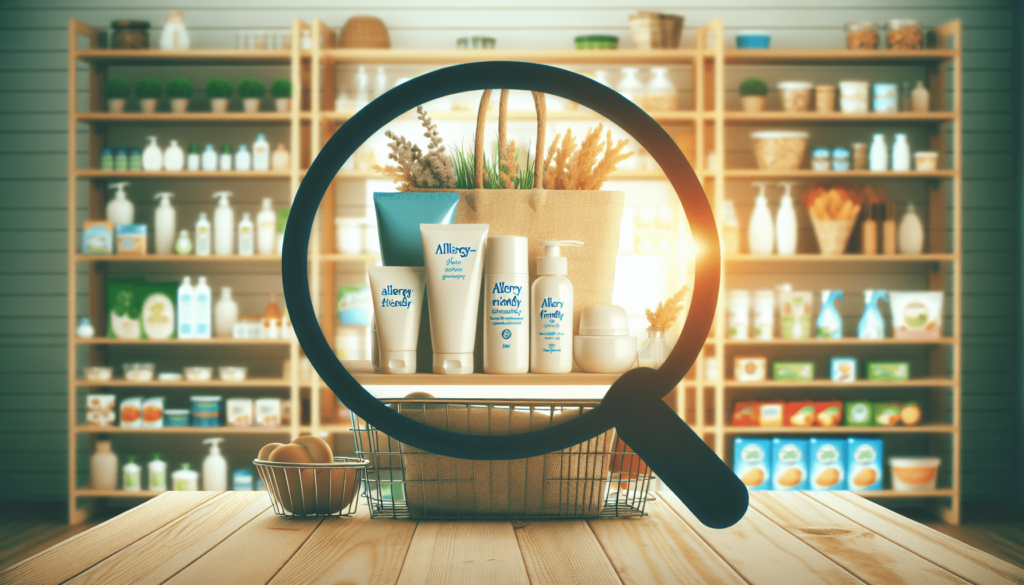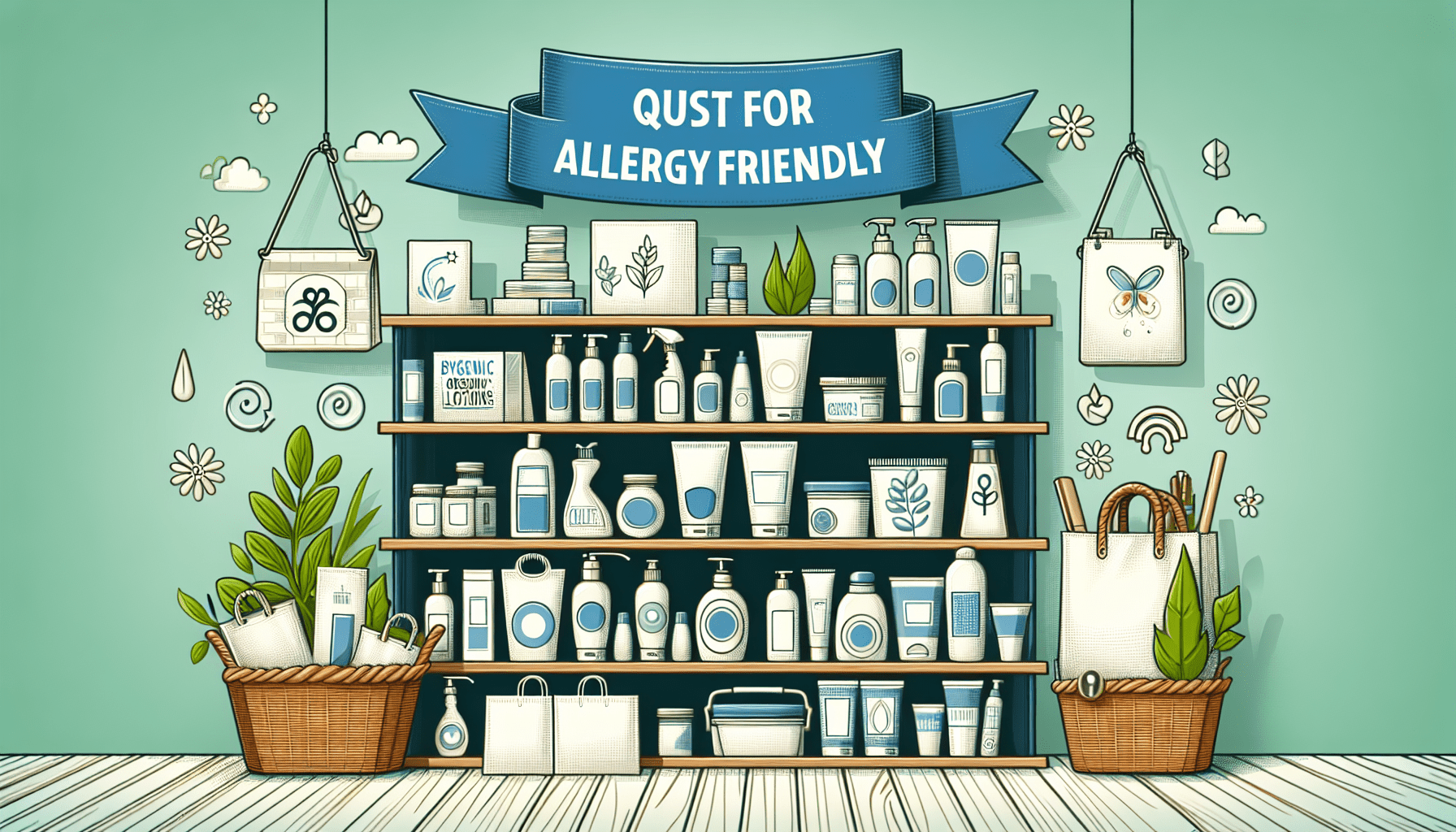Have you ever found yourself puzzled at the grocery store, unsure which products are safe for your allergies? Navigating the world of allergy-friendly products can seem overwhelming, but you’re certainly not alone. Many people are in search of clear, reliable ways to ensure that what they’re purchasing is safe for their lifestyle.
Understanding Allergies
Before we dive into finding allergy-friendly products, it’s essential to understand what allergies are. Allergies occur when your body’s immune system reacts to a foreign substance (allergen). This could be food, pollen, pet dander, or certain chemicals. The reaction can range from mild symptoms like sneezing or itching eyes to severe reactions like anaphylaxis.
Common Food Allergies
Knowing the most common allergies is the first step in avoiding them. This is especially important when it comes to food, as food allergies require constant vigilance.
| Common Food Allergens | Examples of Where They Can Be Found |
|---|---|
| Nuts (peanuts, tree nuts) | Snack bars, candy, granola, baked goods |
| Dairy | Cheese, yogurt, chocolate, cream sauces |
| Gluten | Bread, pasta, cereals, baked goods |
| Shellfish | Shrimp, crab, lobster, certain sauces and broths |
| Soy | Soy sauce, some processed foods, certain snacks |
| Eggs | Baked goods, pasta, meatloaf, some dressings |
Reading Labels Effectively
One of the most important skills you can develop is the ability to read and understand product labels. This can help you identify if a product contains allergens that you need to avoid.
Ingredients List
Always start with the ingredients list. By law, in many countries, common allergens must be clearly stated in the ingredients list. Look for anything that might be unfamiliar; sometimes allergens can be listed under less recognizable names.
Allergen Statements
Many products include an allergen statement, usually found near the ingredients list. This will indicate whether the product contains any of the common allergens or was produced in a facility that also processes those allergens. This is crucial for avoiding cross-contamination.
Finding Specialized Stores and Brands
Finding stores and brands that cater specifically to allergy-friendly products can make your shopping experience far more pleasant. Here’s how you can find them.
Health Food Stores
Health food stores often have a wider selection of allergy-friendly products, including gluten-free, dairy-free, and nut-free options. Many even have special sections dedicated to such items.
Specialty Brands
Several brands focus exclusively on producing allergen-free foods. Brands like Enjoy Life, MadeGood, and Bob’s Red Mill offer a variety of products that cater to different dietary restrictions.
Online Retailers
Shopping online gives you access to a broader range of products and allows you to filter search results based on your specific needs. Websites like Thrive Market and Amazon have extensive selections of allergy-friendly products and often have customer reviews that can be quite informative.
Using Mobile Apps and Technology
Technology can be a useful ally in your quest to find allergy-friendly products. Numerous mobile apps designed for people with allergies can help make shopping safer and easier.
Apps for Scanning Barcodes
Several apps allow you to scan a product’s barcode to see if it contains any allergens. Some popular options include ShopWell, Yummly, and Substitutions.
Allergy Alert Apps
In addition to scanning products, some apps provide alerts for restaurant menus and new products on the market. These can be particularly useful when dining out or traveling.

Learning from Communities and Forums
Sometimes the best advice comes from others who are going through the same experience. Participating in online communities and forums can give you practical tips and recommendations.
Online Forums
Websites like Reddit have forums dedicated to people with allergies. These forums can be a treasure trove of information, from product recommendations to emergency tips.
Social Media Groups
Platforms like Facebook have numerous groups focused on managing allergies. Joining these groups can provide a sense of community and offer additional resources.
Consulting Healthcare Professionals
Your healthcare provider can be an invaluable resource when it comes to managing allergies. They can offer tailored advice, suggest nutritional plans, and sometimes introduce you to products you may not have come across otherwise.
Allergists
If you haven’t already, consider seeing an allergist. They can conduct tests to determine your specific allergies and provide expert advice on how to manage them.
Dietitians
If your allergies are food-related, a dietitian can help you manage your diet while ensuring it remains balanced and nutritious. They can recommend alternatives and sometimes even brands that suit your needs.
Making Your Own Products
One sure way to avoid allergens is to make products yourself. This approach gives you complete control over the ingredients.
Homemade Food
Cooking at home allows you to ensure that there is no cross-contamination. You can find numerous recipes online that cater to specific dietary needs. Websites like AllRecipes and Allergy Free Alaska have sections dedicated to allergy-friendly cooking.
DIY Household Products
Sometimes, it’s not just about food. If you have allergies to certain chemicals found in household products, making your own cleaners, detergents, and soaps can be a safer option. Many DIY recipes are available online.
Checking Certifications and Labels
Certifications can offer an added layer of confidence when purchasing products. Many organizations provide certifications for allergy-friendly products. Look for labels like “Certified Gluten-Free,” “Dairy-Free,” or “Nut-Free.” Here are some common certifications to look for:
| Certification | What It Indicates |
|---|---|
| Certified Gluten-Free | The product contains less than 20 ppm of gluten. |
| NPA Natural Seal | The product contains natural ingredients and is free from synthetic additives. |
| USDA Organic | The product is free from synthetic chemicals, although not necessarily allergen-free. |

Exploring Subscription Boxes
Subscription boxes dedicated to allergy-friendly products can offer a convenient way to discover new products. These boxes often come with a variety of snacks, cooking ingredients, and even household items tailored to your specific needs.
Popular Subscription Boxes
Some popular options include:
| Subscription Box | Description |
|---|---|
| SnackNation | Offers a variety of snacks, including allergen-free options. |
| Love with Food | Provides different subscription plans with allergy-friendly snacks. |
| Allergy-Friendly Foods | A niche box that focuses specifically on allergen-free foods. |
Seeking Allergy-Friendly Dining Options
Eating out with allergies can be tricky, but with the right approach, it can also be enjoyable. Here are ways to find allergy-friendly dining options:
Restaurant Reviews and Apps
Websites like Yelp often have reviews that mention how accommodating a restaurant is for people with allergies. Apps like AllergyEats provide ratings and reviews specifically centered on how well a restaurant caters to different dietary restrictions.
Direct Communication
Always inform the restaurant staff about your allergies before ordering. Asking detailed questions about the menu and food preparation can ensure that your food is safe.
Opting for Whole Foods
Sometimes, the simplest solution is to opt for whole foods. Whole foods like fruits, vegetables, and fresh meats are less likely to contain hidden allergens compared to processed foods.
Benefits of Whole Foods
Whole foods are not only healthier but also significantly reduce the risk of allergen contamination. They are a great option for a nutritious diet while managing allergies.
Sourcing Alternatives
Finding substitutes for common allergens is another useful strategy. This can help you enjoy your favorite recipes without compromising on taste or safety.
Ingredient Substitutes
Here are some common substitutes for allergens:
| Allergen | Substitute |
|---|---|
| Milk | Almond milk, soy milk, coconut milk |
| Eggs | Applesauce, mashed bananas, commercial egg replacer |
| Wheat flour | Almond flour, coconut flour, gluten-free flour |
| Sugar | Stevia, honey, maple syrup, agave nectar |
Educating Family and Friends
It’s important that those around you are aware of your allergies and understand how to help keep you safe. Educate your family and friends about your allergies so that they can support you.
Informational Sessions
Consider hosting a quick informational session with your close circle to help them understand the severity and details of your allergies.
Staying Up-to-Date
Allergen information and products constantly change. New products get launched, and manufacturing processes get updated. Keeping up-to-date with this information is key to managing your allergies effectively.
Newsletters and Websites
Subscribe to newsletters or regularly visit websites dedicated to allergy-friendly living. This helps you stay informed about new products, recalls, and any changes in regulations.
Preparing for Emergencies
Despite all precautions, accidents can happen. Being prepared for emergencies is crucial.
Carrying Emergency Medications
Always have your emergency medications, like an EpiPen, easily accessible. Inform those around you on how to use it in case of a severe allergic reaction.
Emergency Contact Information
Keep a list of emergency contact numbers and medical ID information with you. This can be lifesaving if you have a severe reaction.
Conclusion
Finding allergy-friendly products for your lifestyle might seem daunting at first, but with these strategies, it becomes manageable. Remember, the more information and resources you have at your disposal, the easier it will be to lead a safe and fulfilling life. Your journey to finding allergy-friendly products is personal, and with the right tools and support, you can navigate it successfully.
